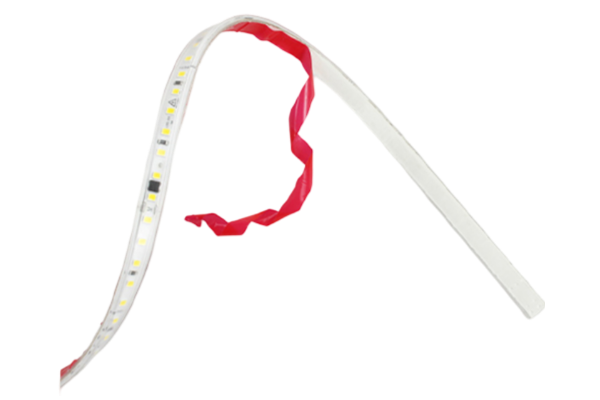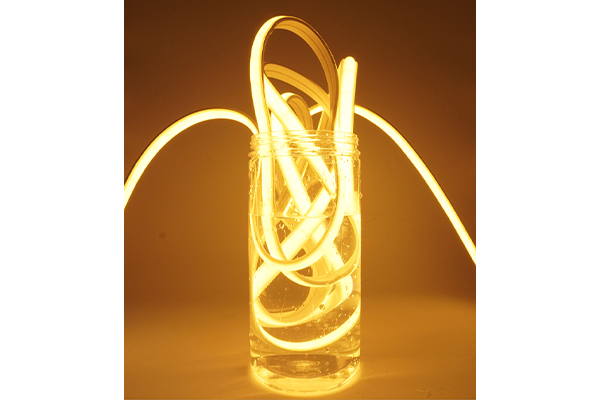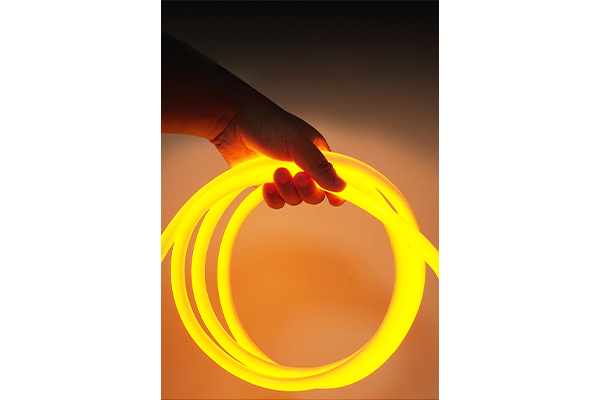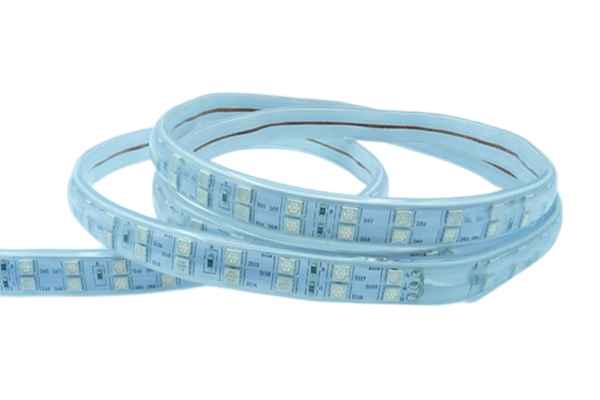How do low-voltage soft light strips achieve the ultimate soft light effect of "flexing freely and seamlessly"?
Release Time : 2025-10-22
In modern interior lighting design, light has long transcended its basic function of simply illuminating a space, becoming a crucial artistic element in creating atmosphere, outlining features, and enhancing aesthetics. Low-voltage soft light strips, with their ultra-thin, flexible, and customizable features, are a key tool for achieving the ideal "light without lamp." Whether in ceiling gaps, cabinet interiors, stair treads, curved walls, or furniture contours, soft light strips can be installed with "flexing freely and seamlessly," delivering a uniform, soft, and continuous light experience.
1. Flexible Substrate: The Physical Basis for Free-Bending
The key to the "flexible" nature of low-voltage soft light strips lies in their use of flexible FPC as a substrate material. This substrate, composed of a laminate of polyimide film and ultra-thin copper foil, offers exceptional flexibility and flex resistance, allowing it to be bent thousands of times without damaging the circuitry. LEDs, resistors, and other electronic components are precisely soldered onto the FPC, forming an extremely thin strip structure, typically only 2-4 mm thick and 8-12 mm wide. The overall structure is as light and flexible as "circuit paper tape." This structure allows it to easily conform to curved, wavy, and even irregular surfaces, enabling installation angles and paths that are impossible with traditional rigid fixtures.
2. High-Density LED Layout: Creating a "Seamless" Lighting Effect
To achieve a "seamless" visual effect, flexibility alone is not enough; it also needs to address issues such as intermittent and grainy light. Low-voltage soft light strips utilize a high-density LED arrangement to significantly reduce the spacing between the LEDs, increasing the overlap of light points and making individual light sources difficult to distinguish with the naked eye. This creates a continuous, uniform light strip. Combined with a secondary optical design, the light is gently diffused, eliminating the glare of point sources and creating a smooth, delicate "light curtain" effect, truly achieving "invisible illumination."
3. Cuttable and Connectable Design: Adaptable to Various Space Requirements
Low-voltage soft light strips typically feature standard cut marks on the FPC, allowing users to cut at designated locations based on desired lengths and reconnect them using dedicated connectors or soldering. This modular design not only avoids material waste but also allows for segmented installation in complex spaces, such as wrapping around an entire living room ceiling or running step by step along a staircase. Furthermore, the low-voltage power supply offers high safety and stability. Even when connecting multiple segments, consistent brightness is maintained, ensuring a consistent and uniform lighting effect, as long as the power supply is matched.
4. Low-Voltage Drive: Ensuring Safe and Stable Lighting
Low-voltage soft light strips utilize a 12V or 24V DC power supply and require a dedicated constant-voltage power supply. This low-voltage design significantly reduces the risk of electric shock and is particularly suitable for humid or sensitive areas such as bathrooms, kitchens, and children's rooms. It also reduces energy loss during long-distance transmission. Combined with appropriate wiring planning, it effectively prevents voltage drop-induced dimming at the ends of the strip. Furthermore, low-voltage systems are more compatible with dimmers, controllers, and smart gateways, enabling intelligent functions such as brightness adjustment, color changing, and timer switching, further enhancing the flexibility and comfort of the lighting environment.
5. Diverse Installation Methods: Achieving "Invisible Integration"
To achieve a seamless fit, low-voltage soft light strips support multiple installation methods. They come with 3M double-sided adhesive on the back, allowing them to be directly attached to clean, flat surfaces. They can also be embedded in aluminum troughs, improving heat dissipation while enhancing light uniformity and aesthetics. They can also be secured to curved surfaces or suspended structures using clips or cable ties. This is particularly true in applications such as suspended ceilings, cabinets, and built-in furniture. The light strips can be hidden in gaps, diffusing light upward or downward to create a suspended light effect, significantly enhancing the sense of depth and luxury in the space.
The low-voltage soft light strip's ability to achieve an ultra-soft, "flexible" and seamless fit is a result of the synergistic effect of a flexible substrate, high-density LEDs, optical diffusion, a low-voltage driver, and an intelligent installation system. It's more than just a lighting tool; it's a shaper of spatial aesthetics.
1. Flexible Substrate: The Physical Basis for Free-Bending
The key to the "flexible" nature of low-voltage soft light strips lies in their use of flexible FPC as a substrate material. This substrate, composed of a laminate of polyimide film and ultra-thin copper foil, offers exceptional flexibility and flex resistance, allowing it to be bent thousands of times without damaging the circuitry. LEDs, resistors, and other electronic components are precisely soldered onto the FPC, forming an extremely thin strip structure, typically only 2-4 mm thick and 8-12 mm wide. The overall structure is as light and flexible as "circuit paper tape." This structure allows it to easily conform to curved, wavy, and even irregular surfaces, enabling installation angles and paths that are impossible with traditional rigid fixtures.
2. High-Density LED Layout: Creating a "Seamless" Lighting Effect
To achieve a "seamless" visual effect, flexibility alone is not enough; it also needs to address issues such as intermittent and grainy light. Low-voltage soft light strips utilize a high-density LED arrangement to significantly reduce the spacing between the LEDs, increasing the overlap of light points and making individual light sources difficult to distinguish with the naked eye. This creates a continuous, uniform light strip. Combined with a secondary optical design, the light is gently diffused, eliminating the glare of point sources and creating a smooth, delicate "light curtain" effect, truly achieving "invisible illumination."
3. Cuttable and Connectable Design: Adaptable to Various Space Requirements
Low-voltage soft light strips typically feature standard cut marks on the FPC, allowing users to cut at designated locations based on desired lengths and reconnect them using dedicated connectors or soldering. This modular design not only avoids material waste but also allows for segmented installation in complex spaces, such as wrapping around an entire living room ceiling or running step by step along a staircase. Furthermore, the low-voltage power supply offers high safety and stability. Even when connecting multiple segments, consistent brightness is maintained, ensuring a consistent and uniform lighting effect, as long as the power supply is matched.
4. Low-Voltage Drive: Ensuring Safe and Stable Lighting
Low-voltage soft light strips utilize a 12V or 24V DC power supply and require a dedicated constant-voltage power supply. This low-voltage design significantly reduces the risk of electric shock and is particularly suitable for humid or sensitive areas such as bathrooms, kitchens, and children's rooms. It also reduces energy loss during long-distance transmission. Combined with appropriate wiring planning, it effectively prevents voltage drop-induced dimming at the ends of the strip. Furthermore, low-voltage systems are more compatible with dimmers, controllers, and smart gateways, enabling intelligent functions such as brightness adjustment, color changing, and timer switching, further enhancing the flexibility and comfort of the lighting environment.
5. Diverse Installation Methods: Achieving "Invisible Integration"
To achieve a seamless fit, low-voltage soft light strips support multiple installation methods. They come with 3M double-sided adhesive on the back, allowing them to be directly attached to clean, flat surfaces. They can also be embedded in aluminum troughs, improving heat dissipation while enhancing light uniformity and aesthetics. They can also be secured to curved surfaces or suspended structures using clips or cable ties. This is particularly true in applications such as suspended ceilings, cabinets, and built-in furniture. The light strips can be hidden in gaps, diffusing light upward or downward to create a suspended light effect, significantly enhancing the sense of depth and luxury in the space.
The low-voltage soft light strip's ability to achieve an ultra-soft, "flexible" and seamless fit is a result of the synergistic effect of a flexible substrate, high-density LEDs, optical diffusion, a low-voltage driver, and an intelligent installation system. It's more than just a lighting tool; it's a shaper of spatial aesthetics.







